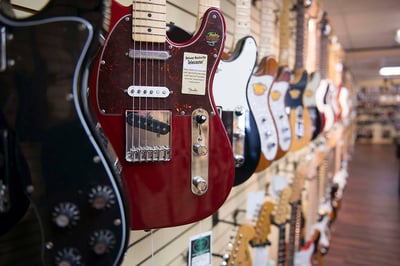
Let’s share. Seriously, give me some comments on this one because I want to know your strategy for buying a guitar.
For most that I know, it’s simply: Find a guitar you like, with the sound you want, and buy it! Oh, how I wish my mind worked like that.
I have a variety of guitars, and most of them are bizarre Frankenstein mutations to which most guitarists wouldn’t give a second look. They are the results of my strategy. Although I happen to love them and the sounds they produce, I’m quite aware that I developed my guitar buying strategy, in part, because of my utilitarian (some may say miserly) nature. Even the prize of my collection – a ’69 Les Paul Gold Top – was the result of a series of ingenious trade-ups while I was in high school. A ’68 Gibson Melody Maker
traded for a ’63 Jaguar, which I then negotiated into a trade along with $125 for that Les Paul that had been sitting in a music store window for 3 years. I have a total of $425 invested in that wonderful guitar (that was in 1972).
I don’t know how I got this way. Perhaps some dimly recalled financial trauma from an early age – something about my big brother and a piggy bank that never seemed to fill up even though I donated daily...
My strategy was further shaped by a couple pieces of good advice I received when I was still in high school. First was a music store owner who explained to me the fundamentals of how electric guitars produce their sound: Metal strings and magnetic pickups. All other components of the guitar simply diminish what the strings and pickups would produce on their own. He taught me to play a guitar unplugged, and look for volume, sustain, and rich tones. In recent years, Paul Reed Smith has filled in the remainder of this knowledge base with his excellent workshops on the physics of guitar tone, along with a brilliant TEDx talk on the subject. That music store owner was absolutely correct.
The second key piece of advicecame when, after a few years of owning the Les Paul, I decided that I wanted a Strat instead. Many of my guitar heroes were playing Strats, so being young and easily influenced, I went shopping for a trade. I was in a guitar store trying out Strats and said to the salesman, “It’s gonna be hard getting used to these. I really don’t like the way the neck feels.”
He laughed at me. “Then why do you want one? Would you buy a pair of shoes if you knew they would hurt your feet?” I said, “Yeah, I guess you’re right. That would be stupid.” That conversation stuck with me. It also stuck with my girlfriend, who was with me at the time. She had just spent hours shopping for a pair of shoes that hurt her feet. Things did not go the way I had hoped that evening.
So, from that point on, my philosophy was: If the guitar feels great to play, is mechanically sound (truss rod, frets, neck joint, etc.), and sounds good unamplified, it can be made to sound great amplified. And thus began my journey into guitar modification. I entered a universe populated with pickups, pots of various resistance, capacitors, resistors, and DPDT switches.
I stalked used guitar racks and pawn shops. If I found a guitar that met my criteria and it was less than $250, I would buy it. I was willing to spend up to $200 on pickups, electronics, etc. to experiment on it. Looking back, I think I came up with those arbitrary figures because I couldn’t bear the thought of spending more on an experiment than I had on the Les Paul. The 1990’s were a great era for used guitar deals in New Orleans, and I found some treasures. Some are still with me (I call them my "Cheapskate Collection"). Others were traded or, in many cases, stolen.

I found first-run Tokai strats, lots of 86-90 Jackson/Charvels (whose necks I still love dearly – especially with the sharkfin fretboards), an Epiphone Sheraton, a Washburn Mercury II (after recently adding SSL-1s and a Pearly Gates neck p/u in the bridge, this is one of my all-time favorites), several Kramers. And, after a time, my experiments gravitated toward as much diversity in sound as possible, using inexpensive guitars that felt great in my hands.
One such monstrosity is a 1986 Charvel Model 4 that I picked up in 2007 for, of course, less than $250. Its pickups now include a J200, a vintage Hot Rails, and an EMG H-4 through an active mid-boost circuit. Sounds like a hot mess? I have never played a guitar that I can get such a wide range of tones out of. It’s like wearing four or five guitars at once. I love the ugly, distortion-infested beast.
Don’t get me wrong, I would love to own a Private Stock PRS Custom 24. They are gorgeous, incredible sounding instruments. But I’m just not wired that way. I get all quivery inside when I see the new line of Paul Reed Smith’s SE guitars. I don’t know that I’ve ever seen more bang-for-buck in a musical instrument. And while I’m playing one (unamplified, of course), I’m dreaming of the diabolical experiments I could perform on it.
So what’s your philosophy? What’s your disease? I want to hear.
